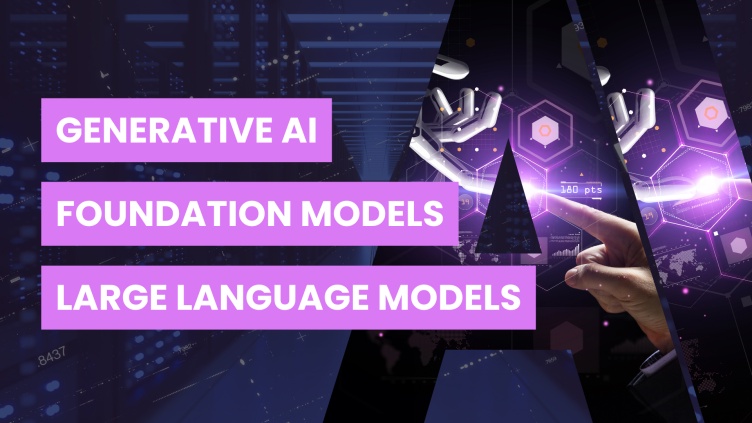In recent years, the field of artificial intelligence has witnessed remarkable advancements, particularly in the development of sophisticated language models that have transformed the way we interact with machines. Among the key players in this AI revolution are Generative AI, Large Language Models, and Foundation Models. While these terms are often used interchangeably, they have distinct characteristics and serve different purposes. In this article, we will delve into the differences between these three categories of AI models to provide a better understanding of their respective roles and capabilities.
Generative AI:
Generative AI refers to a class of artificial intelligence models that are capable of generating creative content, often in the form of text, images, or even audio. These models are designed to produce novel output that is not directly copied from the input data. Generative AI systems, like GANs (Generative Adversarial Networks) and VAEs (Variational Autoencoders), work by learning patterns and generating content from scratch based on those patterns. Some popular examples of Generative AI include:
GANs (Generative Adversarial Networks): GANs consist of two neural networks, a generator, and a discriminator, which work in opposition to produce realistic outputs. GANs have been used to create realistic images, deepfakes, and more.
VAEs (Variational Autoencoders): VAEs are used to generate data by learning the underlying structure and variability within a dataset. They have applications in image generation and text generation.
Recurrent Neural Networks (RNNs): RNNs are used for sequence-to-sequence tasks, making them suitable for text generation, language translation, and more.Generative AI is a broad field with applications across various domains, including art, entertainment, content generation, and even scientific research.
Key characteristics of Generative AI:
a. Creativity: Generative AI systems are designed to be creative and produce content that is not found in their training data. They can generate new ideas, artworks, or text that is unique and often unpredictable.
b. Variability: These models can produce a wide range of outputs, making them useful in creative tasks such as art, music, and storytelling.
c. Not language-focused: While Generative AI can work with text, it is not limited to language generation and can be used for various creative applications.
Large Language Models:
GPT (Generative Pre-trained Transformer): The GPT series, such as GPT-2 and GPT-3, are renowned for their text generation capabilities. They are often used for tasks like language translation, content generation, and chatbots.
BERT (Bidirectional Encoder Representations from Transformers): BERT models are designed for natural language understanding and perform exceptionally well on tasks like sentiment analysis, question-answering, and more.
Large Language Models are versatile and can be fine-tuned for specific tasks, making them valuable tools in various applications, from chatbots and virtual assistants to content generation and text classification.
Key characteristics of Large Language Models:
a. Language-centric: Large Language Models are primarily designed for natural language processing tasks, making them exceptionally good at tasks like text completion, conversation, and text summarization.
b. Transfer learning: They leverage pre-training on massive text corpora to generalize to various language-related tasks, making them versatile and adaptable.
c. Not necessarily creative: While Large Language Models can generate text, their output is often limited to producing coherent and contextually relevant content. They are less focused on creative, novel generation compared to other Generative AI models.
Foundation Models:
Foundation Models are at the forefront of AI research and technology. These models are designed to serve as the basis for a wide range of AI applications, including both language-related tasks and other domains. They are often large-scale models, like GPT-3 or its successors, and serve as the foundation upon which specialized models can be built.
Some examples of Foundation Models include:
OpenAI's GPT-3: While GPT-3 is a Large Language Model, it can also be viewed as a Foundation Model because of its extensive knowledge base and versatility in various applications, beyond just text generation.
Google's T5 (Text-To-Text Transfer Transformer): T5 is a model that frames all NLP tasks as a text-to-text problem, making it highly adaptable to a wide range of tasks.
Foundation Models serve as a base upon which developers and researchers can build specialized AI applications. They provide a strong starting point for various domains, such as natural language processing, computer vision, and more.
Key characteristics of Foundation Models:
a. Versatility: Foundation Models are general-purpose and versatile, capable of being fine-tuned for specific applications. They can serve as the starting point for various AI tasks beyond language processing, such as image recognition and even medical diagnosis.
b. Scalability: These models are often extremely large, with millions or even billions of parameters, allowing them to capture vast amounts of knowledge and nuances.
c. Potential for creative tasks: While not their primary focus, Foundation Models can be used for creative tasks when fine-tuned and adapted, but their primary strength lies in their versatility and adaptability.
Conclusion
In summary, Generative AI, Large Language Models, and Foundation Models are distinct categories of artificial intelligence models, each with its own set of characteristics and applications. Generative AI is known for its creativity and versatility in generating content, while Large Language Models, like GPT-3, excel in natural language processing tasks. Foundation Models serve as the cornerstone for a wide array of AI applications, providing a versatile starting point for specialized models. Understanding the differences between these categories is crucial for leveraging their capabilities effectively and choosing the right model for specific tasks in the evolving landscape of artificial intelligence.


No comments yet